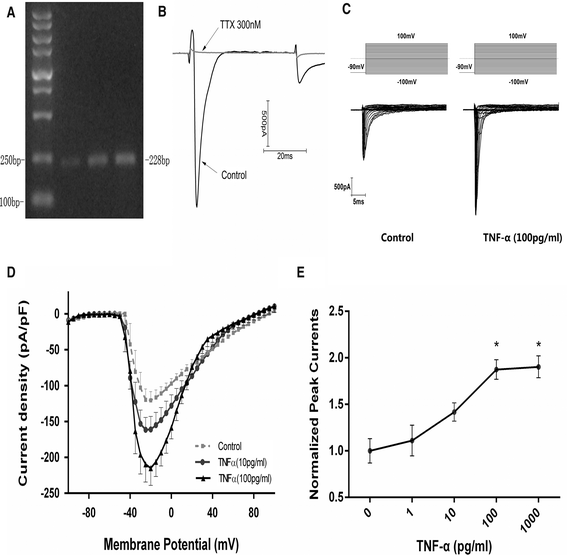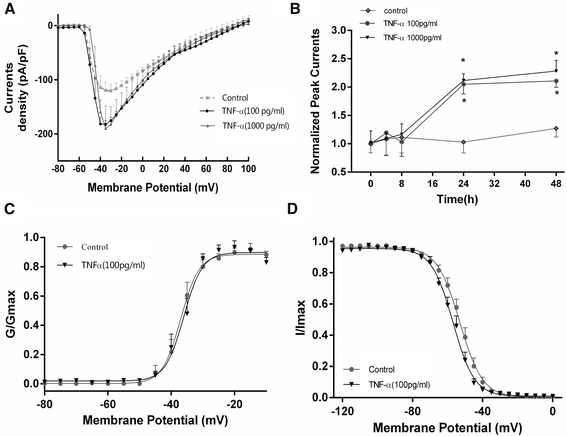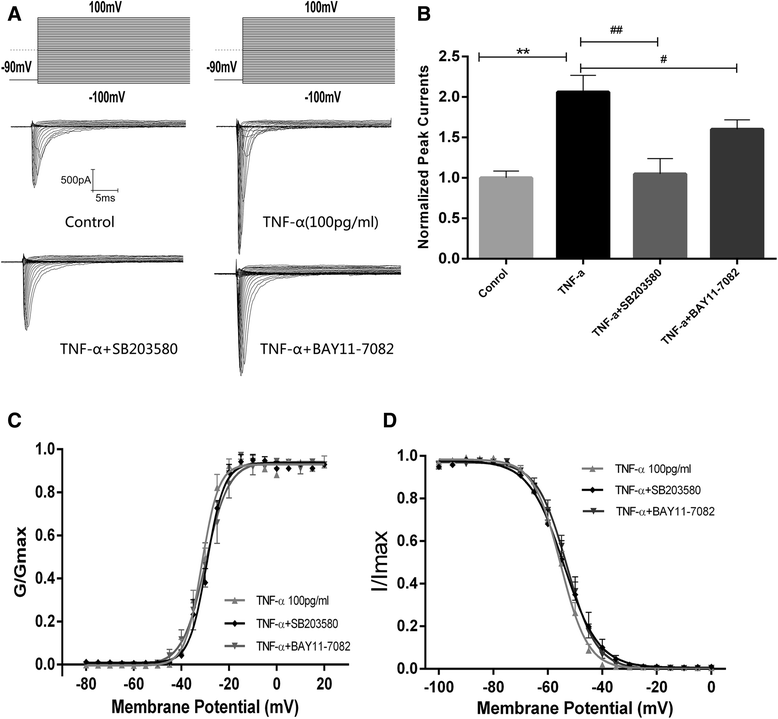Tumor necrosis factor-α enhances voltage-gated Na⁺ currents in primary culture of mouse cortical neurons
- PMID: 26112872
- PMCID: PMC4510892
- DOI: 10.1186/s12974-015-0349-x
Tumor necrosis factor-α enhances voltage-gated Na⁺ currents in primary culture of mouse cortical neurons
Abstract
Background: Previous studies showed that TNF-α could activate voltage-gated Na(+) channels (VGSCs) in the peripheral nervous system (PNS). Since TNF-α is implicated in many central nervous system (CNS) diseases, we examined potential effects of TNF-α on VGSCs in the CNS.
Methods: Effects of TNF-α (1-1000 pg/mL, for 4-48 h) on VGSC currents were examined using whole-cell voltage clamp and current clamp techniques in primary culture of mouse cortical neurons. Expression of Nav1.1, Nav1.2, Nav1.3, and Nav1.6 were examined at both the mRNA and protein levels, prior to and after TNF-α exposure.
Results: TNF-α increased Na(+) currents by accelerating the activation of VGSCs. The threshold for action potential (AP) was decreased and firing rate were increased. VGSCs were up-regulated at both the mRNA and protein levels. The observed effects of TNF-α on Na(+) currents were inhibited by pre-incubation with the NF-κB inhibitor BAY 11-7082 (1 μM) or the p38 mitogen-activated protein kinases (MAPK) inhibitor SB203580 (1 μM).
Conclusions: TNF-α increases Na(+) currents by accelerating the channel activation as well as increasing the expression of VGSCs in a mechanism dependent upon NF-κB and p38 MAPK signal pathways in CNS neurons.
Figures





Similar articles
-
Transient Receptor Potential Vanilloid 4-Induced Modulation of Voltage-Gated Sodium Channels in Hippocampal Neurons.Mol Neurobiol. 2016 Jan;53(1):759-768. doi: 10.1007/s12035-014-9038-5. Epub 2014 Dec 15. Mol Neurobiol. 2016. PMID: 25502461
-
Chronic haloperidol increases voltage-gated Na+ currents in mouse cortical neurons.Biochem Biophys Res Commun. 2014 Jul 18;450(1):55-60. doi: 10.1016/j.bbrc.2014.05.081. Epub 2014 May 27. Biochem Biophys Res Commun. 2014. PMID: 24875357
-
Brivaracetam differentially affects voltage-gated sodium currents without impairing sustained repetitive firing in neurons.CNS Neurosci Ther. 2015 Mar;21(3):241-51. doi: 10.1111/cns.12347. Epub 2014 Dec 1. CNS Neurosci Ther. 2015. PMID: 25444522 Free PMC article.
-
Dual roles of voltage-gated sodium channels in development and cancer.Int J Dev Biol. 2015;59(7-9):357-66. doi: 10.1387/ijdb.150171wb. Int J Dev Biol. 2015. PMID: 26009234 Free PMC article. Review.
-
Mini-review - Sodium channels and beyond in peripheral nerve disease: Modulation by cytokines and their effector protein kinases.Neurosci Lett. 2021 Jan 10;741:135446. doi: 10.1016/j.neulet.2020.135446. Epub 2020 Nov 6. Neurosci Lett. 2021. PMID: 33166641 Review.
Cited by
-
Tumor Necrosis Factor Alpha Induces Neural Stem Cell Apoptosis Through Activating p38 MAPK Pathway.Neurochem Res. 2016 Nov;41(11):3052-3062. doi: 10.1007/s11064-016-2024-8. Epub 2016 Aug 16. Neurochem Res. 2016. PMID: 27528245
-
Cytokine cascades induced by mechanical trauma injury alter voltage-gated sodium channel activity in intact cortical neurons.J Neuroinflammation. 2017 Mar 31;14(1):73. doi: 10.1186/s12974-017-0847-0. J Neuroinflammation. 2017. PMID: 28359334 Free PMC article.
-
Axon hyperexcitability in the contralateral projection following unilateral optic nerve crush in mice.Brain Commun. 2022 Oct 3;4(5):fcac251. doi: 10.1093/braincomms/fcac251. eCollection 2022. Brain Commun. 2022. PMID: 36267329 Free PMC article.
-
Preventing synaptic deficits in Alzheimer's disease by inhibiting tumor necrosis factor alpha signaling.IBRO Rep. 2018 Feb 2;4:18-21. doi: 10.1016/j.ibror.2018.01.003. eCollection 2018 Jun. IBRO Rep. 2018. PMID: 30135948 Free PMC article. Review.
-
Direct effects of prolonged TNF-α and IL-6 exposure on neural activity in human iPSC-derived neuron-astrocyte co-cultures.Front Cell Neurosci. 2025 Feb 12;19:1512591. doi: 10.3389/fncel.2025.1512591. eCollection 2025. Front Cell Neurosci. 2025. PMID: 40012566 Free PMC article.
References
Publication types
MeSH terms
Substances
LinkOut - more resources
Full Text Sources
Other Literature Sources

